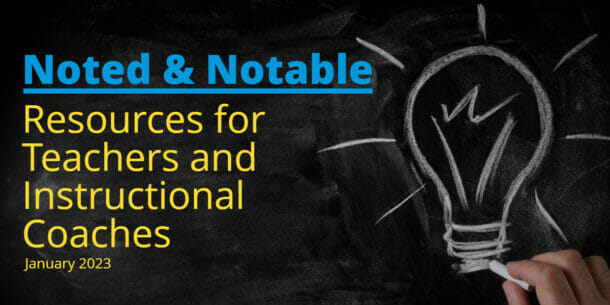Resources for Teachers and Instructional Coaches – January 2023

A new year brings a fresh start to classrooms and is the perfect time to set new goals for teaching and coaching.
Perhaps you’re a teacher working on increasing edtech use with students or an instructional coach supporting teachers to foster strong mathematical thinking. We’ve gathered helpful recent resources for teachers and coaches from January 2023.
Find highlights of classroom strategies, article links, and related content below.
Classroom tech integration should support student communication and choice
From apps to games to even virtual reality, there is a lot of classroom-based edtech out there for teachers to choose from. It can be tempting to add more digital options to your classroom to harness the connectivity and innovation that new tech for learners can offer.
But classroom tech integration should be meaningful and intentional, to avoid turning into screen overload.
This Edutopia article suggests 3 questions that teachers can ask themselves to decide more effectively if the edtech platform or tool they are considering is classroom-worth.
Here are the 3 questions to help teachers determine if a new classroom technology will help students’ engagement and collaboration.
-
Will this technology expand student-to-student communication?
When students can communicate with others about their ideas, their understanding deepens. Luckily, new technologies offer far more avenues for classroom communication than we’ve ever had before. Students can use their devices for digital writing and editing, composing photos or videos, or responding to polls.
These technologies enhance student-to-student communication rather than block it—allowing students to see more of their classmates’ ideas, give each other feedback, and collaboratively revise their thinking. As you assess technology integration options, ask yourself: “Is this new digital tool, software, or platform increasing student-to-student communication or is it decreasing it?”
2. Will this technology expand possibilities for student choice?
By expanding students’ access to new technologies, you can open up learning possibilities that were previously unavailable.
Now, digital technologies expand the topics that our students can investigate and allow them to share knowledge through multimodal compositions. However, in many classrooms, we’re integrating technology in ways that narrow students’ options for engaging and participating rather than widening opportunities for student choice.
In some classrooms, students log in to software where each step of the learning process has been predetermined for them, and their job is to simply click through to the next task. This mode of instructional delivery is not much different than students progressing through paper worksheet prompts and problems. As you assess technology integration options, ask yourself: “Is this digital tool, software, or platform allowing my students choice, or is it funneling them down a predetermined path?”
3. Will this technology enhance assessment?
New technologies can offer us access to incredible amounts of data about our students. Where previously we only had access to information about students’ learning based on what they told us verbally or in writing, digital tools now keep records of almost everything: how students spend their time, what their early drafts or first attempts look like, and who they communicate with and in what ways.Often, these snapshots offer educators a view into their students’ digital performance with color-coded labels, such as a green “meets standard” check mark or a red “below standard” label. What they fail to offer educators is the kind of nuanced information you get from checking in and talking with students. Educators are then left to wonder, is the platform labeling some of my students as “below standard” because they truly don’t understand the concepts or because they’re not using the software properly? Is the platform labeling my students as “meeting standard” because they’ve mastered the content or because they’ve figured out how to game the system?
While digital tools can offer us a pulse check of students’ digital activity, they rarely offer us the whole picture. It can be helpful to ask: “Is this technology automating assessment, or is it providing useful data that can help inform more holistic assessments of students’ learning?”
Read more about each of the questions to help decide when and how to integrate new classroom technologies at Edutopia: Managing Tech Integration in Your Classroom
Still overwhelmed by trying to choose the right edtech for your classroom? Read what edtech expert Monica Burns shares what to prioritize when choosing tech tools.
How to support all students to think mathematically
Mathematical thinking can sometimes feel daunting or abstract to students. How can teachers support students to all feel access to approaching word problems and equations?
This MiddleWeb article shares five strategies that are focused on instructional routines that help “provide access and support to a wide range of learners.”
Here is one easy strategy to incorporate for supporting mathematical thinking for students of all different learning abilities:
Use sentence starters and frames.
Sentence frames and starters present a skeleton of a sentence that helps students organize and communicate their thoughts.
Sentence frames and starters also orient thinking and help students who struggle with executive function to organize their ideas. They lower student anxiety when used during partner, small group, or full group sharing because they support both the speaker and the audience.
High-leverage sentence frames and starters provide accessible language, can be completed in multiple ways, and hone in on mathematical thinking rather than procedures or answers. A few samples include:
- I noticed…so I ….
- … connects to … because…
- Every time ….
To read the other four strategies for supporting students’ mathematical thinking, check out the full article at MiddleWeb: Use These Five Strategies to Support Math Thinking for All
Students getting frustrated with rigorous math thinking? Read what Zaretta Hammond said about helping students embrace productive struggle.
Did you miss last month’s edition of resources for teachers and coaches? Catch up on the December 2022 top resources for teachers and coaches!



